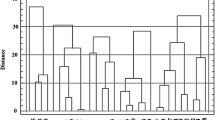Abstract
Forty wheat varieties was evaluated for grain yield in the field for two successive crop seasons (2009–10 and 2010–11), with 2 dates of sowing, viz., early (last week of October) and late (first week of December). Based on the yield potential, five high yielding and five low yielding varieties were selected to study the relationship between grain yield and root characteristics along with canopy temperature depression (CTD) and flag leaf drying under early and late sown conditions. It was observed that under early sown restricted irrigation conditions the high yielding varieties utilized energy in increasing the root length and root density to deeper soil depths instead of accumulating root weight, compared to low yielding varieties. In contrast, under late sown condition, the high yielding varieties had more root weight and density in their upper soil depths, compared to low yielding varieties. Hence, it can be suggested to select wheat varieties with high root density and more root length in the lower depths of the soil for rainfed/restricted irrigation conditions to mitigate the early heat effects, and varieties having high root density and more root length in the upper layers of the soil for late sown conditions to tolerate the late or terminal heat. Further, high CTD scores at 1st stage (vegetative) and high leaf score at fourth stage (post flowering) were found to be important selection parameters, which help in reducing the evapo-transpiration and increase 1000 grain weight under early sown limited irrigation condition, and thereby increase the grain yield; whereas, CTD at 3rd stage (flowering stage) contribute to maintain the stay green trait for longer period and reduce the loss due to evapo-transpiration and in-turn increase the grain yield under late sown conditions. These traits can be used as selection tools for physiological breeding programme to increase the production and productivity of wheat.

Similar content being viewed by others
References
Angadi, S. V., & Entz, M. H. (2002). Root system and water use patterns of different height sunflower cultivar. Agronomy Journal, 94, 136–145.
Chaudhary, T. N., & Bhatnagar, V. K. (2003). Wheat root distribution, water extraction pattern and grain as influenced by time and rate of irrigation. (Ref. will be given).
Chun, L., Guohuo, Mi, Jiansheng, Li, Fanjun, C., & Fusuo, Z. (2005). Genetic analysis of maize root characteristics in response to low nitrogen stress. Plant and Soil, 276, 369–382.
Fischer, R. A., Byerlee, D., & Edmeades, G. O. (2010). Can technology deliver on the yield challenge 2050; Expert Meeting on how to feed the word in 2050. Proceedings of Food and Agriculture organization of the United Nations Economic and Social Development Department.
Hurd, E. A. (1974). Phenotype and drought tolerance in Wheat. Agricultural Meteorology, 14(1–2), 39–55.
Rahnama, A., Munns, R., Poustini, K., & Watt, M. (2011). A screening method to identify genetic variation in root growth response to a salinity gradient. Journal of Experimental Botany, 62(1), 69–77.
Rauf, S. (2008). Breeding Sunflower (Helianthus annus L.) for drought resistance. Communications in Biometry and Crop Science, 3, 29–44.
Rauf, S., & Sadaquat, H. A. (2007). Effect of varied water regimes on root length, dry matter partitioning and endogenous plant growth regulators in sunflower (Helianthus annuus L.). Journal of Plant Interactions, 2, 41–51.
Rauf, S., & Saquat, H. A. (2008). Effect of osmotic adjustment on root length and dry matter partitioning in sunflower (Helianthus annus L.) under drought stress. Acta Agriculturae Scandinavica Section B, 58, 252–260.
Sharma, B. R., & Chaudhary, T. N. (1983). Wheat root growth, grain yield and water uptake as influenced by soil Water regime and depth of nitrogen placement in a loamy sand soil. Agriculture Water Management, 6(4), 365–373.
Watt, M., Kirkegaard, J. A., & Rebetzke, G. J. (2005). A wheat genotype developed for rapid leaf growth copes well with the physical and biological constraints of unploughed soil. Functional Plant Biology, 32, 695–706.
Author information
Authors and Affiliations
Corresponding author
Rights and permissions
About this article
Cite this article
Saxena, D.C., Sai Prasad, S.V., Chatrath, R. et al. Evaluation of root characteristics, canopy temperature depression and stay green trait in relation to grain yield in wheat under early and late sown conditions. Ind J Plant Physiol. 19, 43–47 (2014). https://doi.org/10.1007/s40502-014-0071-1
Received:
Accepted:
Published:
Issue Date:
DOI: https://doi.org/10.1007/s40502-014-0071-1




